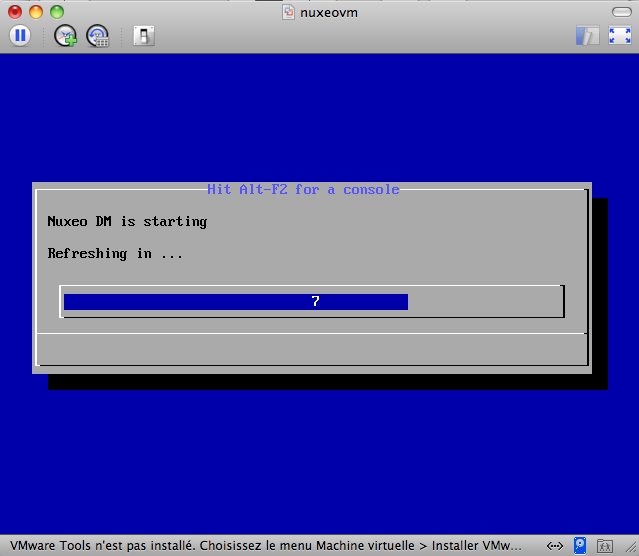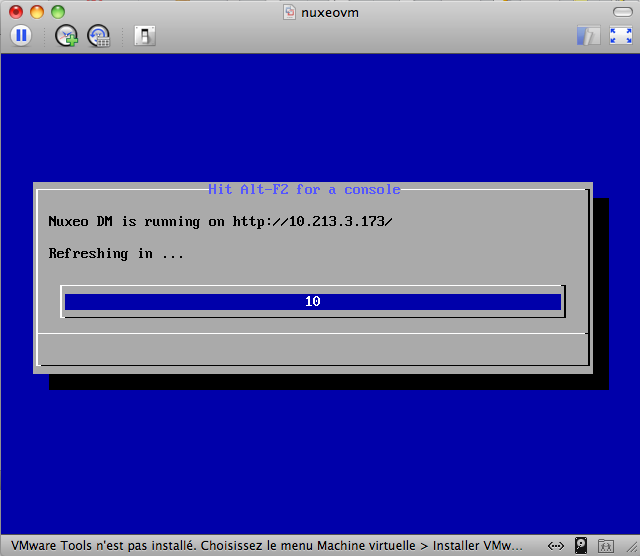On Linux, you can install the Nuxeo Platform using the packages below:
- the ZIP archive,
- the Virtual Machine image,
- the Debian package.
Checking Requirements
The only requirement to run the Nuxeo Platform is to have Java 8u40 (also called Java 1.8.0_40) or a more recent version installed. You need a Java Development Kit (JDK) to develop on the platform, but a JRE is enough to just run it.
Check out the Hardware and Software Requirements for detailed steps to check your Java version and install it.
Installing the Nuxeo Platform from the ZIP Archive
Installing the Nuxeo Platform using the ZIP archive installs the Nuxeo Platform only. External dependencies must be installed separately.
To install the Nuxeo Platform ZIP archive: Unzip the .zip archive using your favorite tool.
What's next? You want to evaluate the platform? You can now start the server. You want to do a complete installation, compatible for a production environment? You should now prepare your environment.
Installing a Nuxeo Virtual Machine Image
The Nuxeo Platform is available as ready-to-use 64b virtual machine images from nuxeo.com. VM images are available for VMWare and Virtual Box. They provide a full environment (OS, database…) and all required dependencies to make the Nuxeo Platform work.
To install the Nuxeo virtual machine image and start Nuxeo:
Unzip the downloaded package.
Do not use the Windows built-in ZIP functionality (aka "zipfldr.dll" or "Compressed Folders Module"), it reports incorrect uncompressed size. Recommended: 7-Zip.
You get a folder with the required file for the virtual machine image to run.
Start the virtual machine image in your virtual machine application by double-clicking on it.
- For the VMWare package, double-click on the file "nuxeo.vmx".
- For the OVF package: in VirtualBox, go to the File menu and choose Import Appliance. Then start the imported virtual machine.The VM image starts.
 Then, the Nuxeo application automatically starts.
Then, the Nuxeo application automatically starts.
 When the Nuxeo application is started, it displays the address at which it is available.
When the Nuxeo application is started, it displays the address at which it is available.


In your browser, type the indicated address. The startup wizard is displayed to help you configure your application.
Shell root accessThe password for the
rootandnuxeousers are generated the first time you start the virtual machine and are displayed on the console.
Limitations:
- As a 64 bit virtual image, it cannot be installed on a 32 bit system.
- MP4 video conversion is not supported because of distribution rights limitations.
Installing the Nuxeo Platform from the APT Repository for Debian and Ubuntu
Installing the Nuxeo Platform using the APT sources for Debian and Ubuntu installs and configures the platform, but it also installs all required dependencies for an optimal use of the platform.
Because no Java 8 package is available before Ubuntu 14.10, Java is not installed automatically with the Nuxeo Platform starting from version 7.2. You need to install it manually before installing the Nuxeo Platform. See the page Hardware and Software Requirements.
You can either install the Nuxeo Platform using the OS graphical user interface or from the terminal.
You will need to know two things first:
- the codename of your distribution (eg trusty for Ubuntu 14.04 LTS)
- which kind of Nuxeo release you want to install (Long Term Support, Fast Track or SNAPSHOT; see the page Nuxeo Release Cycle for more details).
For the examples below, let's say you are using Ubuntu 14.04 LTS ("trusty") and want to install the Nuxeo latest Fast Track release (from the "fasttracks" APT repository; for LTS you would replace "fasttracks" with "releases").
Installing from the APT Sources Using the Graphical User Interface
This requires X11.
- Edit the Software sources: using the Unity Dash, running
gksudo software-properties-gtk, or browsing theSystem/Administration/Software SourcesGnome 2 menu. - Download the Nuxeo key and import it in the Authentication tab.
- Add the Nuxeo APT repository: on the Other Software tab, add
deb [http://apt.nuxeo.org/](http://apt.nuxeo.org/) trusty releasesanddeb [http://apt.nuxeo.org/](http://apt.nuxeo.org/) trusty fasttracksto the sources. (if you're using another version of Ubuntu, replace trusty by the adequate name, for instance raring for Ubuntu 13.04) - Click on that link to install Nuxeo: apt://nuxeo.
- Follow the instructions displayed.
If it's your first install, you can configure:
- the bind address,
- the port,
- the database (a preconfigured PostgreSQL database is suggested by default). The platform is installed as a service. It is automatically started and set to automatically start at boot.
- Open a browser and type the URL
http://NUXEO_SERVER/nuxeo. The startup wizard is displayed so you can setup your Nuxeo platform and select the module you want to install.
Installing from the APT Sources from the Terminal
Import the Nuxeo key.
wget -q -O- http://apt.nuxeo.org/nuxeo.key | sudo apt-key add -Add the Nuxeo APT repository.
sudo add-apt-repository "deb http://apt.nuxeo.org/ $(lsb_release -cs) releases" sudo add-apt-repository "deb http://apt.nuxeo.org/ $(lsb_release -cs) fasttracks"If you don't have
add-apt-repository, which is a non-standard command, issue the following commands:sudo echo "deb [http://apt.nuxeo.org/](http://apt.nuxeo.org/) $(lsb_release -cs) releases" > /etc/apt/sources.list.d/nuxeo.listsudo echo "deb [http://apt.nuxeo.org/](http://apt.nuxeo.org/) $(lsb_release -cs) fasttracks" >> /etc/apt/sources.list.d/nuxeo.listUpdate your APT cache.
sudo apt-get updateInstall the Nuxeo Platform.
sudo apt-get install nuxeoFollow the instructions displayed. If it's your first install, you can configure:
- the bind address
- the port
- the database (a preconfigured PostgreSQL database is suggested by default).
The platform is installed as a service. It is automatically started and set to automatically start at boot.
Open a browser and type the URL
http://NUXEO_SERVER/nuxeo. The startup wizard is displayed so you can setup your Nuxeo platform and select the module you want to install.
Other recommendations
Prevent swapping
Like any Java application you should prevent the JVM Heap to be swapped to disk, this will crush server performance. You have two options here:
- Disable the swap with
sudo swapoff -ayou’ll need to edit your/etc/fstabto disable swap permanently. Note that before doing this you need to make sure that you have enough memory for all the processes that run on the server (Nuxeo JVM, converters, other custom process and the OS). - Limit the swapiness of the OS using
sysctlto setvm.swappiness = 1
Temporary folder
While setting nuxeo.tmp.dir property in nuxeo.conf, we recommend not to use the system temporary folder /tmp because this one can be cleaned up by the operating system. This is in particular the case on Red Hat Enterprise Linux, where systemd-tmpfiles service is deleting old files from /tmp.